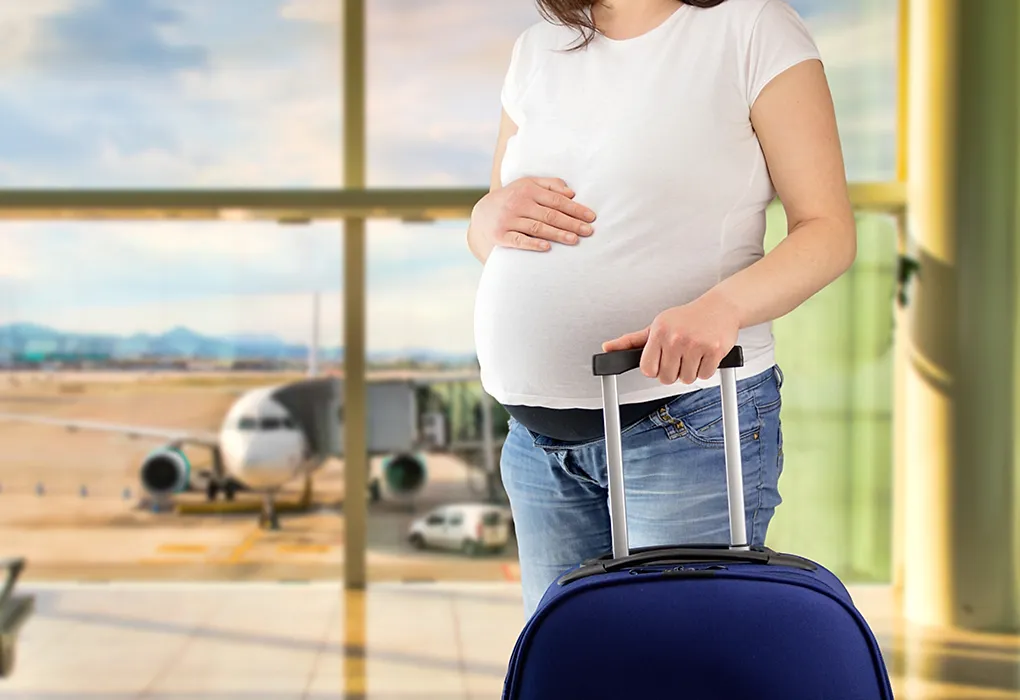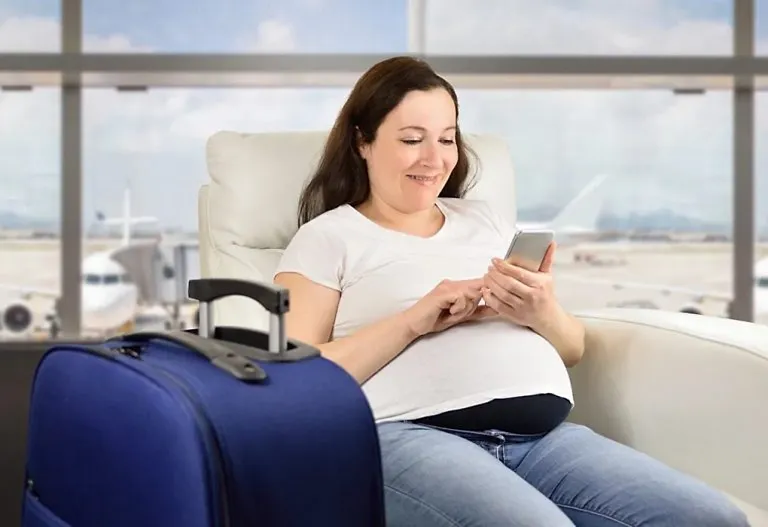Can You Go Through The Airport Scanner During Pregnancy?

Travelling during pregnancy comes with some preparation, both physically and mentally. One big concern is about airport security scanners and how safe they are for a pregnant woman and the baby inside her. There is well-researched evidence that airport security scanners are safe. The technology used in these scanners has been extensively tested and deemed safe for all passengers, including pregnant women. Some common questions include, “Can you go through the airport scanner when pregnant?” and “What are the potential risks of airport pregnancy scanners?” Addressing these concerns can help alleviate stress and ensure a smoother travel experience. Read on to learn all about airport scanners and pregnancy.
What Are Airport Scanners?
Airport scanners are advanced screening gadgets used on airline passengers to detect any security threats that might be attached to their body and/or garments. It is used to identify metallic and non-metallic objects like weapons, explosives, or other stuff like sharp objects (knives), corrosive material, etc. that might be used to harm or threaten other passengers that have boarded the flight.
Types of Airport Scanners
Airport security scanners come in many forms, including-
- Body scanners like millimetre radio-wave scanner that uses millimetre wave Advanced Imaging Technology (AIT) to create 3-D images of your body.
- X-ray scanners like a back-scatter scanner
- Metal detectors
Are Airport Scanners Safe When Pregnant?
According to research, it is proven that all types of airport scanners are safe for pregnant woman and the unborn child. The Radiation Protection Standard stipulates a maximum permissible level of exposure for travellers. This includes expecting mothers and their children.
Moreover, all scanners pass through stringent safety tests, and they are used under the supervision and regulation of monitoring agencies. Did you know that some research suggested that these machines use ten thousand times less energy than the energy used by mobile phones?
Also, they are much more evolved than the older generation scanners. The most modern millimetre body scanners don’t use X-rays or expose your body to ionizing radiation. Of course, if x-ray scanners are used, they are harmless too.
Let’s take a look at the technology used and the exposure levels in the two most modern scanners, and how safe they are for pregnant women:
1. Back-Scatter Scanners
These are X-ray scanners that use low-frequency electromagnetic x-ray waves to search for objects hidden inside a person’s clothing. The low-intensity and low penetration level of the electromagnetic wave cause minimum exposure to rays. Hence, it can cause no harm to a baby developing in the womb. The scanner merely probes through the passengers’ garments and not the skin. According to reputed research firms, the exposure to radiation is well below the limits stipulated. So, both the baby and the mother are safe if they go through this type of airport X-ray scanner during pregnancy.
2. Millimeter-Wave Body Scanners
These scanners simply bounce off the surface of your skin. They do not penetrate inside and merely create a basic outline of your body. So, they cannot cause any harm to either you and your growing foetus. According to the American TSA, these deliver 10,000 times less energy than your cell phone. Still, if you are worried about the safety of airport scanners while pregnant or don’t feel safe about going through them, you can opt for a physical ‘pat-down’ process, as explained in the section above.
3. Metal Detectors
When you are scanned using airport metal detectors during pregnancy, it is perfectly safe. These old-fashioned screeners are still used in many airports. Though they use magnetic fields that are a form of radiation, they are “non-ionizing” radiation and are very low-frequency electromagnetic fields. They merely detect any threatening object you might be carrying. They create the same or lesser intensity of electromagnetic field as the various things we use in our daily lives like electric lines, computers, other household appliances, and even MRI machines used in diagnostic tests. So, they are totally safe during pregnancy.
The Procedure of a Body Scan at Airports
According to the Australian Government Department of Home Affairs, there are a few things you need to do before going through airport body scanners during pregnancy (1)–
- Remove and place all your personal belongings like wallets, tissue paper, ID cards, cellphones into a separate tray for scanning.
- The boarding pass must be removed as well.
- Remove all accessories like jewellery, jackets, belts, shoes, shawls, heavy garments, or any other metal items on your body or garments.
The process includes these steps-
- Enter the scanner machine.
- Stand with both your hands raised above the level of your head.
- Do this for around 2 to 3 seconds while the device captures your image.
Once this is complete, the screening officer will check your scanned image to check if you are carrying any dangerous objects. If you clear the scan, you can proceed to collect all your belongings that have been removed.

The Procedure of Physical Pat-Down Search
If you are wary of scanners, some women prefer a physical pat-down search. You can certainly request the authorities for a pat-down search (2). In this process, a female security professional will run her hands all over your body, even your chest and stomach, to look for any weapons that a person might carry.
If you opt for a physical pat-down screening, it is ideal to reach the airport with some time at hand. This is because this process is more time consuming than machine screening. This type of screening is done in the general screening area, but you may request for a more private pat-down in a separate section. You may also have a companion with you to feel more comfortable.
You might be selected for further screening, and your boarding passes might be printed with indicators. The Transportation Security Administration (TSA) of the airport may need to put you through AIT body screening.
Important Tips to Have a Safe Flight Journey During Pregnancy
Traveling during pregnancy can be a rewarding experience, but it requires careful planning and precautions to ensure both your comfort and safety. Here are some important tips to help you have a safe flight journey during pregnancy:
- Before planning your trip, make sure to get approval from your healthcare provider. They can give you personalised advice based on your pregnancy stage and health condition.
- Choose the right time to travel. The best time to travel during pregnancy is usually during the second trimester, between 14 and 28 weeks, when the risks of complications are lower, and morning sickness has typically subsided.
- Make sure to drink water frequently before and throughout your flight. The low humidity in airplane cabins can cause dehydration, so it’s important to keep your fluid intake up.
- Take regular walks up and down the aisle to promote blood circulation and reduce the risk of deep vein thrombosis (DVT). If you can’t walk, do some in-seat exercises.
- Opt for loose, comfortable clothing and shoes to prevent swelling and improve overall comfort during the flight.
- Keep important items like prenatal vitamins, snacks, a water bottle, and any necessary medications in your carry-on bag for easy access.
FAQs
1. Should I inform airport security personnel that I am pregnant?
While it is not necessary to inform airport security personnel that you are pregnant, it can be helpful. They may offer you the option of a pat-down instead of going through the scanner if you have any concerns. Communicating your pregnancy can also ensure that you receive any additional assistance you might need during the screening process.
2. Are there any alternatives to going through the scanner?
Yes, if you prefer not to go through the scanner, you can request a pat-down screening from airport security personnel. This alternative is always available to any passenger, including pregnant women, who are uncomfortable with passing through the scanners.
3. Do airport scanners pose any risk to breastfeeding?
While airport scanners are generally safe for pregnant women, limited information exists on their impact during breastfeeding. If you have concerns, consult with your healthcare provider or airport security personnel.
4. Can airport scanners detect pregnancy-related items, such as maternity support belts or breast pumps?
Airport scanners are designed to detect metallic and non-metallic items, but specific pregnancy-related items like maternity support belts or breast pumps typically do not trigger alarms. However, it’s advisable to inform airport security personnel about any medical devices or support items before screening.
We have radiation all around us, and airport scanners are devices that emit the least of it. Research suggests that one scan is only about one-tenth of the radiation we are exposed to daily from naturally present sources of radiation around us. So, it is quite certain that they can cause no harm to pregnant women and their foetus.
References/Resources:
1. Security screening at airports; Australian Government Department of Home Affairs; https://www.homeaffairs.gov.au/about-us/what-we-do/travelsecure/security-screening-at-airports
2. Standard Pat-down Search; Transportation Security Administration; https://www.tsa.gov/sites/default/files/foia-readingroom/pat-down_training_procedures_april_2018-1600112rr-1_pt2.pdf
3. Radiation and Pregnancy: Information for Clinicians; CDC Radiation Emergencies; https://www.cdc.gov/radiation-emergencies/hcp/clinical-guidance/pregnancy.html
4. Radiation and Airport Security Scanning; United States Environmental Protection Agency; https://www.epa.gov/radtown/radiation-and-airport-security-scanning
5. Mehta. P, Smith-Bindman. R; Airport Full Body Screening: What is the Risk? (Arch Intern Med); National Libary of Medicine; https://www.ncbi.nlm.nih.gov/pmc/articles/PMC3936792/; March 2011
6. Travelling in pregnancy; NHS; https://www.nhs.uk/pregnancy/keeping-well/travelling/
7. Travel During Pregnancy; American Pregnancy Association; https://americanpregnancy.org/healthy-pregnancy/is-it-safe/travel-during-pregnancy/
Also Read:
Train Travelling in Pregnancy
Travelling By Bus While Pregnant
Travelling by Aeroplane while Pregnant
Was This Article Helpful?
Parenting is a huge responsibility, for you as a caregiver, but also for us as a parenting content platform. We understand that and take our responsibility of creating credible content seriously. FirstCry Parenting articles are written and published only after extensive research using factually sound references to deliver quality content that is accurate, validated by experts, and completely reliable. To understand how we go about creating content that is credible, read our editorial policy here.























